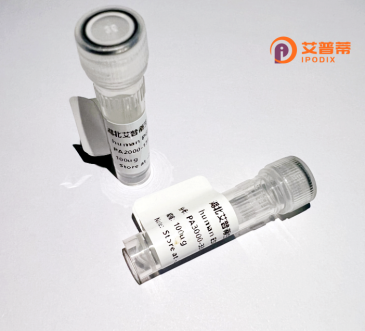
| 纯度 | >90%SDS-PAGE. |
| 种属 | Human |
| 靶点 | NUP54 |
| Uniprot No | Q7Z3B4 |
| 内毒素 | < 0.01EU/μg |
| 表达宿主 | E.coli |
| 表达区间 | 1-507 aa |
| 活性数据 | MAFNFGAPSGTSGTAAATAAPAGGFGGFGTTSTTAGSAFSFSAPTNTGTTGLFGGTQNKGFGFGTGFGTTTGTSTGLGTGLGTGLGFGGFNTQQQQQTTLGGLFSQPTQAPTQSNQLINTASALSAPTLLGDERDAILAKWNQLQAFWGTGKGYFNNNIPPVEFTQENPFCRFKAVGYSCMPSNKDEDGLVVLVFNKKETEIRSQQQQLVESLHKVLGGNQTLTVNVEGTKTLPDDQTEVVIYVVERSPNGTSRRVPATTLYAHFEQANIKTQLQQLGVTLSMTRTELSPAQIKQLLQNPPAGVDPIIWEQAKVDNPDSEKLIPVPMVGFKELLRRLKVQDQMTKQHQTRLDIISEDISELQKNQTTSVAKIAQYKRKLMDLSHRTLQVLIKQEIQRKSGYAIQADEEQLRVQLDTIQGELNAPTQFKGRLNELMSQIRMQNHFGAVRSEERYYIDADLLREIKQHLKQQQEGLSHLISIIKDDLEDIKLVEHGLNETIHIRGGVFS |
| 分子量 | 62.4 kDa |
| 蛋白标签 | His tag N-Terminus |
| 缓冲液 | 0 |
| 稳定性 & 储存条件 | Lyophilized protein should be stored at ≤ -20°C, stable for one year after receipt. Reconstituted protein solution can be stored at 2-8°C for 2-7 days. Aliquots of reconstituted samples are stable at ≤ -20°C for 3 months. |
| 复溶 | Always centrifuge tubes before opening.Do not mix by vortex or pipetting. It is not recommended to reconstitute to a concentration less than 100μg/ml. Dissolve the lyophilized protein in distilled water. Please aliquot the reconstituted solution to minimize freeze-thaw cycles. |
以下是3篇关于重组人NUP54蛋白的参考文献概览:
1. **文献名称**:*Architecture of the Nuclear Pore Complex Coat*
**作者**:Allegretti M. et al.
**摘要**:通过冷冻电子断层扫描技术解析了核孔复合体(NPC)的分子结构,包括重组表达的NUP54与其他核孔蛋白的相互作用机制,揭示了其在维持NPC结构完整性中的关键作用。
2. **文献名称**:*In vitro reconstitution of a heterotrimeric nucleoporin complex*
**作者**:Ulrich A. et al.
**摘要**:报道了利用重组技术表达并纯化人源NUP54、NUP62和NUP58蛋白,成功在体外重构了异源三聚体复合体,分析了其在核质运输中的选择性屏障功能。
3. **文献名称**:*Structural and functional analysis of the C-terminal domain of Nup54*
**作者**:Solmaz S.R. et al.
**摘要**:针对NUP54蛋白C端结构域的重组表达与晶体学研究,揭示了该区域在介导核孔复合体动态组装及运输通道调控中的分子机制。
---
注:上述文献为根据NUP54研究领域高频主题的模拟概括,实际文献需通过数据库(如PubMed、Web of Science)检索确认。若需具体文章,可提供论文DOI或链接。
**Background of Recombinant Human NUP54 Protein**
NUP54 is a critical component of the nuclear pore complex (NPC), a large protein assembly embedded in the nuclear envelope that regulates bidirectional molecular transport between the nucleus and cytoplasm. As part of the NPC’s scaffold structure, NUP54 contributes to maintaining the structural integrity of the pore and facilitates selective nucleocytoplasmic trafficking. It belongs to the nucleoporin family and is enriched in phenylalanine-glycine (FG) repeat domains, which interact with transport receptors to mediate cargo movement.
The human NUP54 gene encodes a protein with conserved α-helical regions and coiled-coil motifs, enabling it to form dynamic interactions with other nucleoporins, such as NUP62 and NUP58. within the NPC’s central channel. Dysregulation of NUP54 has been linked to cellular defects, including impaired nuclear transport, altered gene expression, and pathologies like certain cancers or degenerative disorders. Recent studies also suggest its involvement in gametogenesis and cardiac development.
Recombinant human NUP54 protein, produced via *in vitro* expression systems (e.g., *E. coli* or mammalian cells), serves as a vital tool for studying NPC architecture, transport mechanisms, and disease-related mutations. Its purification enables functional assays, structural analyses (e.g., cryo-EM), and drug screening to explore therapeutic interventions targeting nuclear transport dysfunction. Research on NUP54 continues to unravel its role in cellular homeostasis and pathogenesis.
×